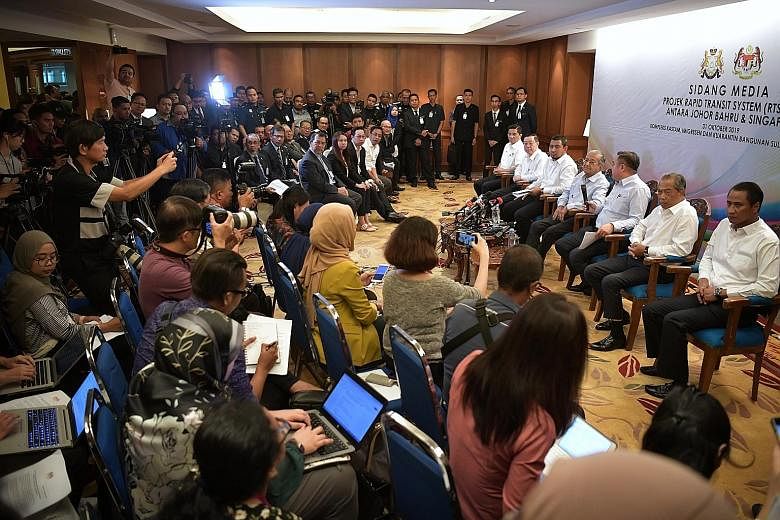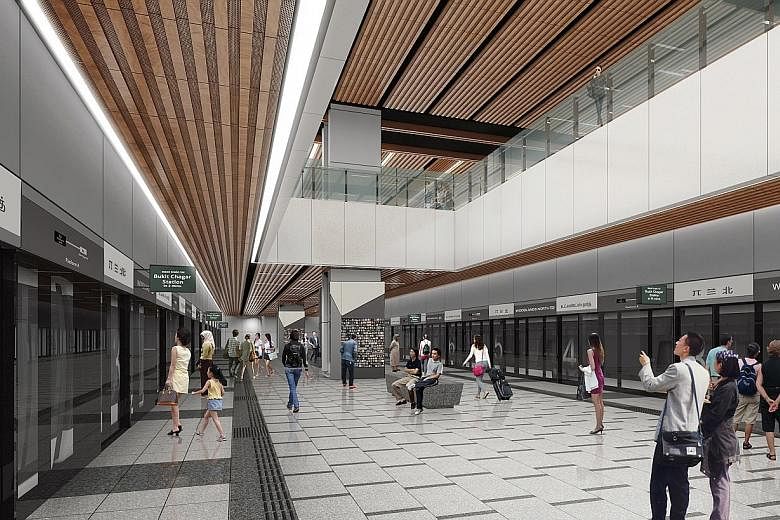Malaysia is proposing that an LRT (Light Rail Transit) system be used for a 4km cross-border rail project between Johor Baru and Singapore, said Malaysian Transport Minister Anthony Loke yesterday.
Using an LRT system - instead of Singapore's MRT system as originally planned - will help to bring down the costs in terms of the capital expenditures and operations, he told reporters.
Mr Loke expressed confidence the LRT system which Malaysia is proposing for the Johor Baru-Singapore Rapid Transit System (RTS) Link can match the planned capacity of the RTS, which is slated to carry up to 10,000 passengers an hour in each direction during peak periods.
"The capacity is almost the same. There is a misconception by some Singaporeans... (The) LRT system that we are proposing is not like the one in Singapore," he said, pointing out that it would be more similar to that used in Kuala Lumpur.
He shared these plans following an announcement by Malaysian Prime Minister Mahathir Mohamad at a press conference in Johor Baru that Malaysia will proceed with the RTS project, which has been delayed several times.
The RTS, aimed at relieving congestion at the Causeway, will connect Woodlands North station on Singapore's Thomson-East Coast MRT line to Bukit Chagar in Johor Baru. When the bilateral deal to build the RTS was inked last year, both countries had agreed that it would use the same core systems - including trains and signalling - as the Thomson-East Coast MRT line, for economies of scale.
When asked about Malaysia's proposal to use an LRT system instead of an MRT system, Singapore's Ministry of Transport said: "We have requested further details from Malaysia on their proposed changes, and are unable to comment further at this point."
National University of Singapore transport analyst Lee Der-Horng said that while LRT carriages carry fewer passengers compared with MRT carriages, trains could arrive at shorter intervals to boost the system's capacity. But he added that this would not be optimal. "LRT carriages are smaller and narrower, while MRT ones are wider, longer and more spacious. The latter has the advantage of allowing passengers to board and alight more quickly."
He said an MRT system is the better choice for the RTS Link, as there will be a high volume of passengers during the peak periods, in a "narrow timeframe".
Mr Loke, when asked what Malaysia will be doing to help relieve congestion at the border crossings - before the RTS is ready - reiterated that the Malaysian government has allocated RM85 million (S$28 million) to tackle the issue.
He said this will mean more immigration counters, upgrading the systems, and combining the immigration and toll collection for cars into a single counter so that vehicles will have to make only one stop.
While Tun Dr Mahathir said the RTS project will go ahead, he separately expressed his preference for another bridge to be built between the two countries, adding that Singapore objected to this proposal.
"We subsidise water for Singapore to the tune of billions of ringgit (since 1962)... by selling water for three sen (1 Singapore cent) per 1,000 gallons. On the other hand, when we want to build a bridge, it's objected to by Singapore," he said.
Human resources executive Chin Yi Yun, 31, said: "I'm looking forward to the RTS getting off the ground. Congestion at Woodlands Checkpoint can be a headache and a rail link like that could make my commute much smoother."
• Additional reporting by Wong Kai Yi
What's next for the RTS Link
The proposed cross-border transit link between Johor Baru and Woodlands looks set to go ahead, after Malaysian Prime Minister Mahathir Mohamad gave it the green light yesterday.
Here are the developments since the 4km Johor Baru-Singapore Rapid Transit System (RTS) Link was first announced.
Several delays
During the 2010 Leaders' Retreat, Prime Minister Lee Hsien Loong and then Malaysian Prime Minister Najib Razak agreed to jointly develop an RTS Link by 2018.
The aim was to enhance connectivity between both countries.
In January last year, both countries signed a legally binding agreement to build the link by Dec 31, 2024. Construction for the project was to have started this year.
But key project deadlines were missed after the Pakatan Harapan coalition led by Tun Dr Mahathir came to power in May last year.
Rail operators SMRT and Prasara-na Malaysia were supposed to form a joint venture (JV) to run the RTS Link by June last year. This venture should then have been appointed the RTS Link operator through a concession agreement with Singapore's Land Transport Authority (LTA) and the Malaysian government by September last year.
Malaysia, however, indicated that it was considering replacing its JV partner, and delayed confirming this partner on several occasions - first until September last year, and then December.
On Dec 28, it asked to be given until Feb 28 this year to do so, and subsequently sought another extension till March 31.
Malaysia then requested to suspend the project for six months from April 1 to review its key parameters, and both sides signed an agreement in May to defer the project until Sept 30.
Singapore later agreed to Malaysia's request for an additional one-month suspension that was to have ended yesterday.
Malaysia yesterday said Prasa-rana will remain its JV partner, and that the operator has been tasked to consult SMRT to finalise the terms of the JV agreement.
What work has Singapore done on the RTS so far?
In 2013, the LTA awarded a $34.2 million contract to infrastructural specialist Aecom to conduct an architectural and engineering study for the link.
A 10ha site in Woodlands North has been set aside for the RTS Link terminus, and LTA has carried out excavation works at the site to reduce by 15m in height what was previously a forested hill. Minimal maintenance works were done at the site during the suspension period.
The LTA has assembled a staff of nearly 70 people to implement the RTS. Civil tenders have also been called, including to build Singapore's RTS Link station and its portion of the crossing bridge.
Amendments to agreements
Yesterday, Malaysian Transport Minister Anthony Loke said both countries are in the midst of discussing and amending three agreements that need to be signed.
The first is the bilateral agreement, followed by the joint venture agreement between SMRT and Prasarana, and finally the concession agreement.
"Of course, the Singapore Government has to review it and it will take some time to study our proposal. And what we will do, we'll have a joint engineering study and that will take a few months, before we can conclude all the agreements," Mr Loke said.
Neither side has provided a new completion date for the RTS Link.
In May, Transport Minister Khaw Boon Wan said the suspension would result in the RTS being delayed by a "couple of years", should both sides agree to proceed after September as per the bilateral agreement.
Responding to queries yesterday, a spokesman for Singapore's Ministry of Transport said discussions with Malaysia "will take some time", as the changes proposed will require amendments to the RTS Link agreement.
What about the KL-Singapore High-Speed Rail (HSR)?
Singapore and Malaysia signed a deal in September last year to suspend the HSR project up to May 31 next year.
First mooted in 2013, the 350km high-speed rail line is slated to shave travel time by land between Singapore and Kuala Lumpur to 90 minutes, compared with more than four hours by car.
With the delay, trains are slated to begin running only on Jan 1, 2031, instead of Dec 31, 2026, as planned originally.
Singapore has said there will be no further postponement beyond May 31 next year.
The project will be deemed to have been terminated by Malaysia if it does not proceed with the HSR project by then.
Malaysia would then have to reimburse Singapore for the project implementation costs incurred by the Republic up to the point of suspension.




